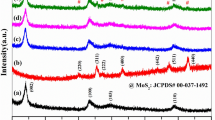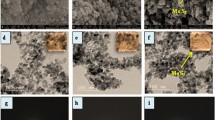Abstract
In this research, zero-dimensional (quantum dots) of graphitic carbon nitride (g-C3N4) and Fe3O4 nanoparticles were decorated on MoS2 nanosheets to prepare MoS2/Fe3O4/g-C3N4 quantum dots. Photocatalytic activities of newly synthesized nanocatalyst were investigated by the degradation of methylene blue (MB) and methyl orange (MO) under visible LED lamp light. In these degradation reactions, the parameters effective such as dyes concentration, pH, amount of catalyst, and irradiation time were also investigated. The systematic investigations revealed that 10 mg of MoS2/Fe3O4/g-C3N4QDs catalyst was optimum to degrade 10 mg/L of MB and 40 mg of nanocatalyst to degrade 10 mg/L of MO with 60 W of LED irradiation. Nanocomposite can act as an excellent photocatalyst for degradation of MB and MO at short time intervals and also can be easily separated by an external magnet and reused several times. The kinetic data acquired for the degradation of dyes were matched to first-order rate equations, and also the apparent rate constants for the degradation of MB and MO were calculated as follows: K = 0.285 min−1 and K = 0.263 min−1, respectively. The novelty of catalyst is due to metal (Mo) and non-metal (S) in the structure of substrate (MoS2), so Fe3O4 and g-C3N4 QDs can be strongly connected to the substrate. The structure and morphology of prepared nanocomposite were characterized by X-ray diffraction (XRD), vibrating sample magnetometer (VSM), transmission electron microscopy (TEM), scanning electron microscopy (SEM) energy dispersive X-ray spectroscopy (EDS), and UV–Vis spectroscopy.
















Similar content being viewed by others
References
M. Mousavi, A. Habibi-Yangjeh, S.R. Pouran, Review on magnetically separable graphitic carbon nitride-based nanocomposites as promising visible-light-driven photocatalysts. J. Mater. Sci.: Mater. Electron. 29(3), 1719 (2018). https://doi.org/10.1007/s10854-017-8166-x
H. Ali, Hybrid treatment systems for dye wastewater. Crit. Rev. Environ. Sci. Technol. 37(4), 315 (2007). https://doi.org/10.1080/10643380601174723
F.I. Hai, K. Yamamoto, K. Fukushi, Effect of some operational parameters on textile dye biodegradation in a sequential batch reactor. J. Biotechnol. 89(3), 163 (2001). https://doi.org/10.1016/S0168-1656(01)00313-3
H. Ali, Biodegradation of synthetic dyes—a review. Water Air Soil Pollut. 213(4), 251 (2010). https://doi.org/10.1007/s11270-010-0382-4
P. Kharazi, R. Rahimi, M. Rabbani, Study on porphyrin/ZnFe2O4@polythiophene nanocomposite as a novel adsorbent and visible light driven photocatalyst for the removal of methylene blue and methyl orange. Mater. Res. Bull. 103, 133 (2018). https://doi.org/10.1016/j.materresbull.2018.03.031
M. Amir, U. Kurtan, A. Baykal, Rapid color degradation of organic dyes by Fe3O4@His@Ag recyclable magnetic nanocatalyst. J. Ind. Eng. Chem. 27, 347 (2015). https://doi.org/10.1016/j.jiec.2015.01.013
A. Srinivasan, T. Viraraghavan, Decolorization of dye wastewaters by biosorbents: a review. J. Environ. Manag. 91(10), 1915 (2010). https://doi.org/10.1016/j.jenvman.2010.05.003
R. Jiraratananon, A. Sungpet, P. Luangsowan, Performance evaluation of nanofiltration membranes for treatment of effluents containing reactive dye and salt. Desalination 130(2), 177 (2000). https://doi.org/10.1016/S0011-9164(00)00085-0
P. Janoš, P. Michálek, L. Turek, Sorption of ionic dyes onto untreated low-rank coal–oxihumolite: a kinetic study. Dyes Pigm. 74(2), 363 (2007). https://doi.org/10.1016/j.dyepig.2006.02.017
W. Yu, X. Liu, L. Pan, J. Li, J. Liu, J. Zhang, Enhanced visible light photocatalytic degradation of methylene blue by F-doped TiO2. Appl. Surf. Sci. 319, 107 (2014). https://doi.org/10.1016/j.apsusc.2014.07.038
X. Wu, D. Zhang, F. Jiao, S. Wang, Visible-light-driven photodegradation of methyl orange using Cu2O/ZnAl calcined layered double hydroxides as photocatalysts. Colloids Surf. A 508, 110 (2016). https://doi.org/10.1016/j.colsurfa.2016.08.047
S. Kumar, V. Maivizhikannan, J. Drews, V. Krishnan, Fabrication of nanoheterostructures of boron doped ZnO-MoS2 with enhanced photostability and photocatalytic activity for environmental remediation applications. Vacuum 163, 88 (2019). https://doi.org/10.1016/j.vacuum.2019.02.001
A. Rani, K. Singh, A.S. Patel, A. Chakraborti, S. Kumar, K. Ghosh, Visible light driven photocatalysis of organic dyes using SnO2 decorated MoS2 nanocomposites. Chem. Phys. Lett. 738, 136874 (2020). https://doi.org/10.1016/j.cplett.2019.136874
A. Beyhaqi, Q. Zeng, S. Chang, M. Wang, S.M.T. Azimi, C. Hu, Construction of g-C3N4/WO3/MoS2 ternary nanocomposite with enhanced charge separation and collection for efficient wastewater treatment under visible light. Chemosphere 247, 125784 (2020). https://doi.org/10.1016/j.chemosphere.2019.125784
C. Nagaraja, M. Kaur, S. Dhingra, Enhanced visible-light-assisted photocatalytic hydrogen generation by MoS2/g-C3N4 nanocomposites. Int. J. Hydrogen Energy 45(15), 8497 (2020). https://doi.org/10.1016/j.ijhydene.2020.01.042
M. Li, J. Shi, L. Liu, P. Yu, N. Xi, Y. Wang, Experimental study and modeling of atomic-scale friction in zigzag and armchair lattice orientations of MoS2. Sci. Technol. Adv. Mater. 17(1), 189 (2016). https://doi.org/10.1080/14686996.2016.1165584
M.-H. Wu, L. Li, N. Liu, D.-J. Wang, Y.-C. Xue, L. Tang, Molybdenum disulfide (MoS2) as a co-catalyst for photocatalytic degradation of organic contaminants: a review. Process Saf. Environ. Prot. 118, 40 (2018). https://doi.org/10.1016/j.psep.2018.06.025
J. Bai, W. Lv, Z. Ni, Z. Wang, G. Chen, H. Xu, Integrating MoS2 on sulfur-doped porous g-C3N4 iostype heterojunction hybrids enhances visible-light photocatalytic performance. J. Alloys Compd. 768, 766 (2018). https://doi.org/10.1016/j.jallcom.2018.07.286
W. Wang, L. Li, K. Wu, G. Zhu, S. Tan, W. Li, Hydrothermal synthesis of bimodal mesoporous MoS2 nanosheets and their hydrodeoxygenation properties. RSC Adv. 5(76), 61799 (2015). https://doi.org/10.1039/C5RA09690A
A.T. Massey, R. Gusain, S. Kumari, O.P. Khatri, Hierarchical microspheres of MoS2 nanosheets: efficient and regenerative adsorbent for removal of water-soluble dyes. Ind. Eng. Chem. Res. 55(26), 7124 (2016). https://doi.org/10.1021/acs.iecr.6b01115
D. Ayodhya, G. Veerabhadram, Stable and efficient graphitic carbon nitride nanosheet–supported ZnS composite catalysts toward competent catalytic performance for the reduction of 4-nitrophenol using NaBH4. Mater. Today Energy 5, 100015 (2019). https://doi.org/10.1016/j.mtsust.2019.100015
J. Wen, J. Xie, X. Chen, X. Li, A review on g-C3N4-based photocatalysts. Appl. Surf. Sci. 391, 72 (2017). https://doi.org/10.1016/j.apsusc.2016.07.030
M. Inagaki, T. Tsumura, T. Kinumoto, M. Toyoda, Graphitic carbon nitrides (g-C3N4) with comparative discussion to carbon materials. Carbon 141, 580 (2019). https://doi.org/10.1016/j.carbon.2018.09.082
Y.S. Ravindra, S.H. Puttaiah, S. Yadav, J.S. Prabagar, Evaluation of polymeric gC3N4 contained nonhierarchical ZnV2O6 composite for energy-efficient LED assisted photocatalytic mineralization of organic pollutant. J. Mater. Sci.: Mater. Electron. 31(19), 16806 (2020). https://doi.org/10.1007/s10854-020-04235-4
L. Jiang, X. Yuan, Y. Pan, J. Liang, G. Zeng, Z. Wu, Doping of graphitic carbon nitride for photocatalysis: a review. Appl. Catal. B 217, 388 (2017). https://doi.org/10.1016/j.apcatb.2017.06.003
X. Lin, C. Liu, J. Wang, S. Yang, J. Shi, Y. Hong, Graphitic carbon nitride quantum dots and nitrogen-doped carbon quantum dots co-decorated with BiVO4 microspheres: a ternary heterostructure photocatalyst for water purification. Sep. Purif. Technol. 226, 117 (2019). https://doi.org/10.1016/j.seppur.2019.05.093
T. An, J. Tang, Y. Zhang, Y. Quan, X. Gong, A.M. Al-Enizi, Photoelectrochemical conversion from graphitic C3N4 quantum dot decorated semiconductor nanowires. ACS Appl. Mater. Interfaces 8(20), 12772 (2016). https://doi.org/10.1021/acsami.6b01534
Q. Liu, D. Zhu, M. Guo, Y. Yu, Y. Cao, Facile and efficient fabrication of g-C3N4 quantum dots for fluorescent analysis of trace copper(II) in environmental samples. Chin. Chem. Lett. 30(9), 1639 (2019). https://doi.org/10.1016/j.cclet.2019.05.058
S. Yan, Z. Li, Z. Zou, Photodegradation performance of g-C3N4 fabricated by directly heating melamine. Langmuir 25(17), 10397 (2009). https://doi.org/10.1021/la900923z
Z. Zhou, Y. Shen, Y. Li, A. Liu, S. Liu, Y. Zhang, Chemical cleavage of layered carbon nitride with enhanced photoluminescent performances and photoconduction. ACS Nano 9(12), 12480 (2015). https://doi.org/10.1021/acsnano.5b05924
X. Zhang, H. Wang, H. Wang, Q. Zhang, J. Xie, Y. Tian, Single-layered graphitic-C3N4 quantum dots for two-photon fluorescence imaging of cellular nucleus. Adv. Mater. 26(26), 4438 (2014). https://doi.org/10.1002/adma.201400111
M. Zarei, N. Seyedi, S. Maghsoudi, M. Shahabi Nejad, H. Sheibani, Synthesis of star-shaped CuO nanoparticles supported on magnetic functionalized graphene: catalytic and antibacterial activity. J. Chin. Chem. Soc. 67(11), 1992 (2020). https://doi.org/10.1002/jccs.202000097
S. Thangavel, S. Thangavel, N. Raghavan, R. Alagu, G. Venugopal, Efficient visible-light photocatalytic and enhanced photocorrosion inhibition of Ag2WO4 decorated MoS2 nanosheets. J. Phys. Chem. Solids 110, 266 (2017). https://doi.org/10.1016/j.jpcs.2017.06.005
X.Q. Qiao, F.C. Hu, F.Y. Tian, D.F. Hou, D.S. Li, Equilibrium and kinetic studies on MB adsorption by ultrathin 2D MoS2 nanosheets. RSC Adv. 6(14), 11631 (2016). https://doi.org/10.1039/C5RA24328A
L. Yang, X. Wu, L. Luo, Y. Liu, F. Wang, Facile preparation of graphitic-C3N4 quantum dots for application in two-photon imaging. New J. Chem. 43(7), 3174 (2019). https://doi.org/10.1039/C8NJ05740K
C.Z. Li, Z.B. Wang, X.L. Sui, L.M. Zhang, D.M. Gu, Graphitic-C3N4 quantum dots modified carbon nanotubes as a novel support material for a low Pt loading fuel cell catalyst. RSC Adv. 6(38), 32290 (2016). https://doi.org/10.1039/C6RA02553F
N.P. Moraes, F.N. Silva, M.L. Silva, T.M. Campos, G.P. Thim, L.A. Rodrigues, Methylene blue photodegradation employing hexagonal prism-shaped niobium oxide as heterogeneous catalyst: effect of catalyst dosage, dye concentration, and radiation source. Mater. Chem. Phys. 214, 95 (2018). https://doi.org/10.1016/j.matchemphys.2018.04.063
P. Mohammadi, H. Sheibani, Green synthesis of Fe3O4@SiO2-Ag magnetic nanocatalyst using safflower extract and its application as recoverable catalyst for reduction of dye pollutants in water. Appl. Organomet. Chem. 32(4), 4249 (2018). https://doi.org/10.1002/aoc.4249
S. Li, J. Liao, Y. Dong, Y. Fu, Y. Zhu, Enhanced photocatalytic activity of ternary g-C3N4/NaTaO3/biomass carbon composite photocatalysts under visible-light radiation. J. Mater. Sci.: Mater. Electron. 31(22), 19613 (2020). https://doi.org/10.1007/s10854-020-04488-z
K. Dai, H. Chen, T. Peng, D. Ke, H. Yi, Photocatalytic degradation of methyl orange in aqueous suspension of mesoporous titania nanoparticles. Chemosphere 69(9), 1361 (2007). https://doi.org/10.1016/j.chemosphere.2007.05.021
S. Sohrabnezhad, Study of catalytic reduction and photodegradation of methylene blue by heterogeneous catalyst. Spectrochim. Acta A 81(1), 228 (2011). https://doi.org/10.1016/j.saa.2011.05.109
P. Mohammadi, H. Sheibani, Evaluation of the bimetallic photocatalytic performance of Resin–Au–Pd nanocomposite for degradation of parathion pesticide under visible light. Polyhedron 170, 132 (2019). https://doi.org/10.1016/j.poly.2019.05.030
Z. Zhu, P. Huo, Z. Lu, Y. Yan, Z. Liu, W. Shi, C. Li, H. Dong, Fabrication of magnetically recoverable photocatalysts using g-C3N4 for effective separation of charge carriers through like-Z-scheme mechanism with Fe3O4 mediator. Chem. Eng. J. 331, 615 (2018). https://doi.org/10.1016/j.cej.2017.08.131
Z. Ma, L. Hu, X. Li, L. Deng, G. Fan, Y. He, A novel nano-sized MoS2 decorated Bi2O3 heterojunction with enhanced photocatalytic performance for methylene blue and tetracycline degradation. Ceram. Int. 45(13), 15824 (2019). https://doi.org/10.1016/j.ceramint.2019.05.085
L. Zou, R. Qu, H. Gao, X. Guan, X. Qi, C. Liu, MoS2/RGO hybrids prepared by a hydrothermal route as a highly efficient catalytic for sonocatalytic degradation of methylene blue. Results Phys. 14, 102458 (2019). https://doi.org/10.1016/j.rinp.2019.102458
L. Shi, Z. He, S. Liu, MoS2 quantum dots embedded in g-C3N4 frameworks: a hybrid 0D–2D heterojunction as an efficient visible-light driven photocatalyst. Appl. Surf. Sci. 457, 30 (2018). https://doi.org/10.1016/j.apsusc.2018.06.132
W. Zhang, X. Xiao, L. Zheng, C. Wan, Fabrication of TiO2/MoS2@zeolite photocatalyst and its photocatalytic activity for degradation of methyl orange under visible light. Appl. Surf. Sci. 358, 468 (2015). https://doi.org/10.1016/j.apsusc.2015.08.054
Author information
Authors and Affiliations
Corresponding authors
Additional information
Publisher's Note
Springer Nature remains neutral with regard to jurisdictional claims in published maps and institutional affiliations.
Supplementary Information
Below is the link to the electronic supplementary material.
Rights and permissions
About this article
Cite this article
Zarei, M., Mohammadzadeh, I., Saidi, K. et al. g-C3N4 quantum dot decorated MoS2/Fe3O4 as a novel recoverable catalyst for photodegradation of organic pollutant under visible light. J Mater Sci: Mater Electron 32, 26213–26231 (2021). https://doi.org/10.1007/s10854-021-06790-w
Received:
Accepted:
Published:
Issue Date:
DOI: https://doi.org/10.1007/s10854-021-06790-w




